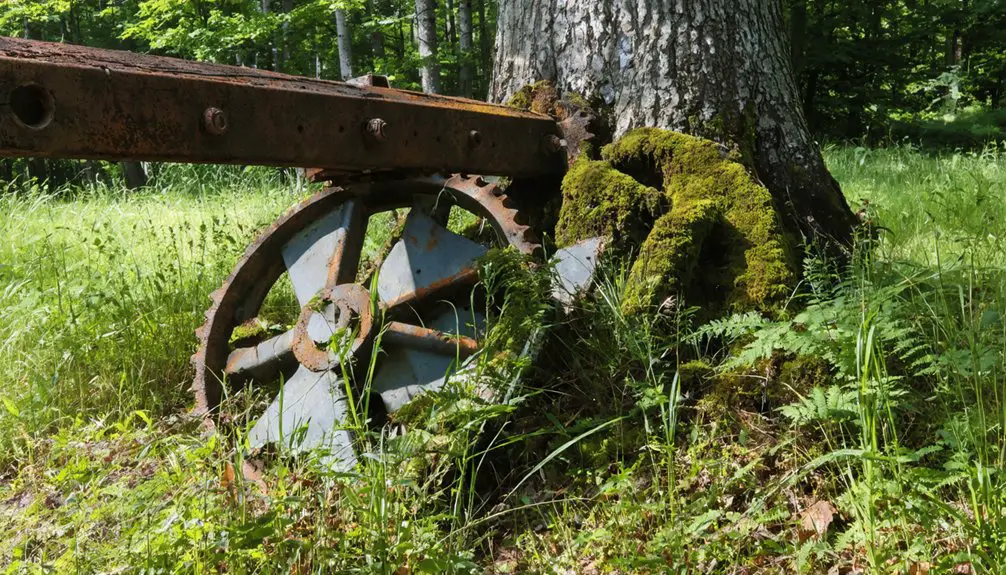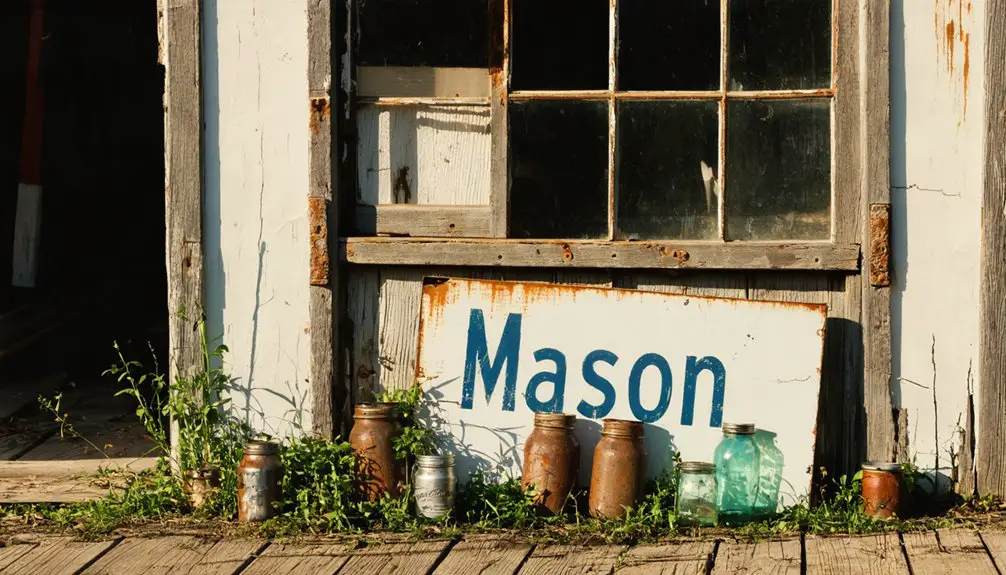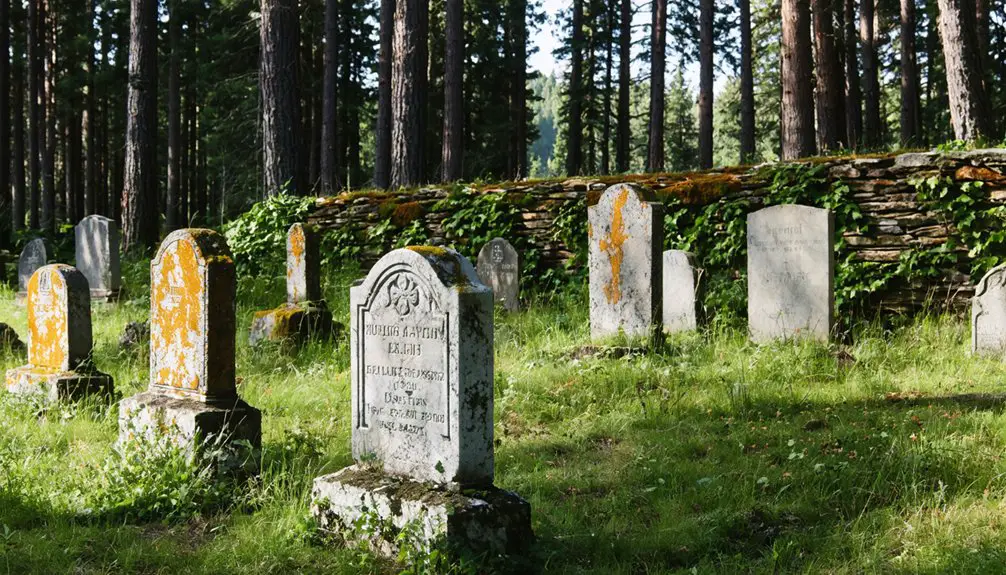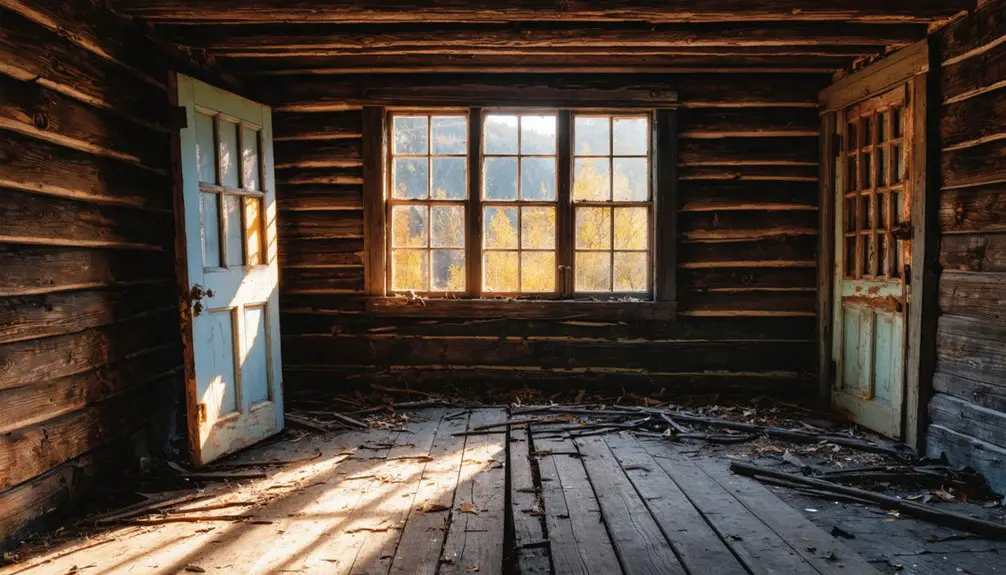You’ll find Sterlingville, a former gold mining boomtown, located near Jacksonville, Oregon. After James Sterling and Aaron Davis discovered gold in Sterling Creek in 1854, the town rapidly grew to over 1,000 residents. The Sterling Mine Company’s innovative hydraulic mining operations made it one of Oregon’s largest gold producers. Today, only the historic Sterlingville Cemetery remains, preserving the stories of nearly 1,500 former residents who shaped this remarkable chapter of Oregon’s mining heritage.
Key Takeaways
- Founded in 1854 after James Sterling’s gold discovery, Sterlingville rapidly grew to over 1,000 residents within months.
- The town flourished with businesses, saloons, and dance halls until hydraulic mining operations became the primary economic activity.
- Sterling Mine Company developed extensive water systems and advanced mining operations, becoming one of Oregon’s largest hydraulic mining enterprises.
- Disease outbreaks, including typhoid and smallpox, impacted the population and contributed to the town’s eventual decline.
- Today, only the Sterlingville Cemetery remains, located 4.2 miles from Buncom, preserving the memory of nearly 1,500 former residents.
The Discovery of Gold and Birth of a Boomtown
After prospecting through the Applegate watershed in 1854, James Sterling and Aaron Davis discovered gold in Sterling Creek, a tributary of Little Applegate Creek.
Though they’d initially staked gold claims near Jacksonville in 1853, they’d lost those due to mining rules. This time, they tried to keep their discovery secret, but word spread quickly, and other miners rushed to stake their claims along the creek before Sterling could return.
Secrecy rarely lasts in gold country – Sterling learned this lesson twice when other miners beat him to his own discoveries.
When Sterling came back, he was offered a reduced claim, which he rejected, choosing instead to return to farming.
The discovery sparked the birth of Sterlingville, which grew rapidly to over 800 people within two years. You’d have found a bustling boomtown complete with stores, boarding houses, saloons, a casino, blacksmith, and barber shop. The town’s population would continue growing, reaching over a thousand residents by fall of 1854. To avoid confusion with other similarly named mining towns, historical records often include a disambiguation page entry for this Oregon settlement.
Life in a Bustling Mining Community
While miners labored tirelessly extracting gold from Sterling Creek, a vibrant community of over 1,500 residents flourished around them.
You’d find a bustling main street lined with essential businesses – a general store, bakery, blacksmith, and barber shop. For local cuisine and entertainment, you could visit the boarding houses or enjoy community events at the dance hall, casino, and saloons.
Daily life wasn’t always easy, though. Epidemics of typhoid, diphtheria, scarlet fever, and smallpox struck the population hard. The Sterling Mine Company constructed an impressive 23-mile water diversion system in 1877 to support their mining operations. Entire families were lost to disease outbreaks, as evidenced by the headstones at Sterlingville Cemetery.
Yet the community persevered, establishing a post office in 1879 and maintaining a school for the children.
The town’s diverse population included miners’ families, Chinese laborers who helped build the vital water infrastructure, and various merchants who kept this energetic mining town running.
The Sterling Mine Company’s Rise to Prominence
You’ll find Sterling Mine Company’s rapid ascent was driven by its innovative hydraulic mining system, which used a gravity-fed 26-mile ditch to blast through 800 cubic yards of earth daily at peak operation.
The company’s technological achievements led it to become the largest hydraulic mining operation in Oregon and possibly the western United States, generating millions in gold production through the efforts of operators like Gin Lin, who managed to extract over $2 million in gold during his mining career.
While the mine’s success transformed the local economy and created the boomtown of Sterlingville, its operations permanently altered the landscape through extensive soil erosion and environmental disruption that remains visible today. The massive construction project required nearly 400 Chinese laborers to complete the extensive ditch system in less than a year.
Mining Technology Innovations
Three major technological innovations propelled the Sterling Mine Company to prominence in the 1870s: hydraulic mining, advanced milling operations, and sophisticated ore processing.
You’ll find the most impressive mining machinery advancement in their 26-mile water ditch, constructed in 1877 using 400 Chinese laborers. This engineering feat supplied water to powerful hydraulic giants that blasted through rock and dirt along Sterling Creek. The introduction of electric power systems significantly enhanced operational efficiency across multiple mines in the region. The operation maintained a 55 yards per hour processing rate through their advanced washing plant design.
The ore processing techniques grew increasingly sophisticated, with mills upgrading their stamp batteries and incorporating electrical power. Greenback’s mill expanded to 50 stamps, processing 180 tons daily. They’d capture 90% of gold values using concentrators and plates before any cyanide treatment was needed.
On-site labs equipped with furnaces and reagents further refined the extraction process, while bucket concentrators efficiently separated gold from black sand.
Record-Breaking Gold Production
The Sterling Mine Company‘s ascent to mining prominence began with James Sterling and Aaron Davis’s 1854 discovery of rich gold deposits along Sterling Creek.
You’ll find their operation quickly became one of Oregon’s largest hydraulic mining enterprises, possibly leading the western U.S. in mining efficiency.
Their daily gold extraction was impressive, blasting through 800 cubic yards of soil to reach valuable deposits.
The gold they sought was embedded in porphyry formation ledges, with pay streaks up to two feet thick.
The mild climate and low altitude of Southern Oregon region allowed for year-round mining operations, contributing to their success.
Local mines like Free Coinage yielded exceptional returns of 21 ounces per 10 tons of ore, with concentrates valued at $150 per ton.
During peak years, the company’s output reached millions in gold value, transforming Sterlingville into a bustling boomtown of 1,500 residents.
Environmental Impact and Legacy
While Sterlingville’s gold mining operations brought tremendous wealth, they also left lasting environmental impacts on the region’s ecosystem.
Environmental contamination remains a significant concern, with arsenic seepage into groundwater and Sterling Creek affecting local water quality even today. Modern mining proposals in Oregon still face similar concerns, with plans to use cyanide extraction processes raising environmental alarms.
The mine’s operations impacted the environment in three major ways:
- Generated 4 million tons of mining byproducts, including toxic waste rock and chemical-laden water
- Disrupted wildlife habitats, particularly affecting sensitive species like sage grouse and bats
- Altered soil composition and increased sediment runoff, damaging aquatic ecosystems
Despite wildlife protection measures and lined containment ponds, the legacy of mining activities continues to shape the landscape.
You’ll find these environmental challenges persist long after the last gold was extracted, serving as a reminder of mining’s lasting footprint on the land.
Environmental Impact and Engineering Feats

You’ll find the Sterling Ditch’s construction in 1877 was an impressive feat of mining engineering, stretching 23 miles to deliver water from Little Applegate River with a 120-foot elevation drop that powered three 5-inch mining nozzles.
The massive scale of hydraulic mining operations at Sterlingville carved away soil and displaced rock piles downstream, making it one of the largest such operations in the western United States.
The environmental devastation from these activities continues to affect the landscape today through residual erosion, altered waterways, and disrupted ecosystems that never fully recovered from the mining era.
Sterling Ditch Construction Achievements
Constructed in 1877 by the Sterling Mine Company, the Sterling Ditch stands as one of Oregon’s most ambitious 19th-century mining infrastructure projects. The ditch engineering masterpiece stretched 26.5 miles, delivering water from the Little Applegate River to power hydraulic mining operations.
Through remarkable labor organization, 400 mostly Chinese workers completed this massive undertaking in just six months.
Key achievements of the Sterling Ditch project include:
- Precise elevation control maintaining a 120-foot drop from source to mines
- Design capacity supporting three 5-inch hydraulic nozzles simultaneously
- Strategic route planning across challenging terrain for ideal water flow
You’ll find the ditch’s legacy preserved today as a recreational trail, tribute to the incredible feat of 19th-century engineering and determination that shaped Oregon’s mining history.
Hydraulic Mining’s Lasting Effects
Despite its economic benefits, hydraulic mining at Sterlingville left profound and lasting changes on the landscape that remain visible today.
You’ll find massive sediment deposition from “slickens” – a mix of sand, silt, and gravel – that clogged river channels and buried agricultural lands downstream. The powerful water cannons, known as giants, blasted away creek banks and created deep artificial channels, some tunneling 1,700 feet underground.
The environmental impact extends beyond altered waterways. The removal of vegetation and topsoil led to increased erosion, while mining debris contaminated soil properties, markedly delaying ecological restoration.
Though some former mining structures now serve recreational purposes, many areas remained barren for decades due to disturbed soils and altered drainage patterns that disrupted native plant communities.
Native American History and Displacement
Before Sterlingville’s founding as a mining settlement in 1854, the Upland Takelma (Latgawa) and Dakubetede peoples had long inhabited the region, maintaining their traditional ways of life until increasing conflicts with white settlers led to their forced removal.
Despite Native resilience in defending their ancestral lands since the 1830s, you’ll find that cultural disruption accelerated dramatically after gold’s discovery.
Native peoples showed remarkable strength protecting their homelands, but the discovery of gold brought swift and devastating changes.
The Rogue River Indian Wars marked a turning point, leading to:
- Forced treaty signatures in 1853 under intense pressure
- Violent militia attacks against Native camps in 1854
- Mass relocation to coastal reservations by 1856
The establishment of hydraulic mining operations devastated traditional Native territories, permanently altering waterways and destroying resources that had sustained Indigenous communities for generations.
Daily Life and Social Structure

Life in Sterlingville reached its vibrant peak during the mid-1850s when the population swelled to 1,500 residents, transforming the settlement from a simple mining camp into a structured frontier town.
You’d find a mix of miners, families, and merchants living alongside each other, with social gatherings centered around the town’s saloons, dance hall, and gambling houses.
While miners worked the gold deposits, their families created a sense of permanence through the establishment of a school district and boarding houses.
Yet daily life wasn’t without its harsh realities. Health challenges plagued the community, as epidemics of typhoid, diphtheria, smallpox, and scarlet fever swept through regularly.
The Sterlingville Cemetery, with its numerous children’s graves, stands as a memorial to the frontier town’s struggle with disease and the fragile nature of frontier life.
The Town’s Gradual Decline
The gradual erosion of Sterlingville’s prosperity began in the 1870s, when empty buildings started dotting the once-bustling streets.
Population shifts hit the town hard as gold reserves depleted, causing severe economic struggles that would ultimately seal its fate.
You can trace the town’s decline through these key developments:
- The post office’s brief operation (1879-1883) reflected the community’s shrinking population
- Disease outbreaks, including typhoid and diphtheria, devastated entire families
- The school district’s closure in 1937 signaled the community’s final descent
Preservation Through the Cemetery

Standing as the sole physical remnant of Sterlingville’s existence, the town’s cemetery lies 4.2 miles from Buncom, Oregon, where it preserves the memories of nearly 1,500 former residents from the settlement’s gold rush heyday.
You’ll find the cemetery’s historical significance etched in headstones that tell stories of pioneers like Patrick Fehely and his wife Sarah Jane, alongside sobering reminders of 19th-century epidemics that claimed many lives, particularly children.
Local historical societies maintain the site, which you can access via a dirt road through an aluminum gate. The surrounding eucalyptus and fir trees create a protective barrier, while cemetery preservation efforts guarantee this vital link to Oregon’s mining heritage endures.
For historians and genealogists, it’s an invaluable resource documenting the region’s gold rush era.
Legacy of a Lost Settlement
Despite its complete physical disappearance, Sterlingville’s influence persists through remarkable historical records that paint a vivid picture of Oregon’s gold rush era.
The town’s cultural memory lives on through three key legacies:
- The Sterling Mine Company’s distinction as possibly the largest hydraulic gold mine in Oregon and the western U.S.
- The Sterling Ditch’s innovative 23-mile water diversion system that revolutionized regional mining techniques.
- The preserved cemetery that tells poignant stories of pioneer life, disease outbreaks, and family tragedies.
The historical significance of Sterlingville extends beyond its brief existence, reflecting broader themes of American westward expansion, Indigenous displacement, and the volatile nature of mining economies.
You’ll find its story interwoven with regional conflicts, technological advancement, and the human cost of frontier development.
Frequently Asked Questions
What Happened to James Sterling After the Town Was Established?
You won’t find detailed records of James Sterling’s later life, though his legacy endured through the town’s name and mining claims. Sterling’s influence continued through the region’s largest hydraulic mining operation.
Were There Any Famous Outlaws or Notable Crimes in Sterlingville?
You won’t find any outlaw legends or notorious crimes documented in historical records. While the town had typical boomtown saloons and gambling houses, no famous criminals or significant criminal events are verified.
How Did Residents Celebrate Holidays and Special Occasions in Sterlingville?
You’d find holiday traditions centered around dance halls, saloons, and boarding houses, with festive gatherings including music, shared meals, and seasonal celebrations at the school and through religious observances.
What Happened to the Mining Equipment After the Town Was Abandoned?
You’ll find most mining equipment was dismantled, scrapped, or left to decay after 1957. Nature reclaimed what remained, with few pieces preserved for historical documentation by local historical societies.
Did Any Original Sterlingville Buildings Survive and Get Relocated Elsewhere?
You won’t find any original structures from Sterlingville preserved elsewhere. Historical preservation records show no buildings were relocated, with only the cemetery remaining as physical evidence of the town’s existence.
References
- https://www.oregonencyclopedia.org/articles/sterlingville/
- https://www.roy-stevenson.com/ghost-towns-oregon.html
- https://en.wikipedia.org/wiki/Sterlingville
- https://www.oregonencyclopedia.org/articles/buncom/
- https://www.travelmedford.org/southern-oregon-ghost-towns-
- https://www.historicjacksonville.org/sterling-ditch-trail/
- https://visitgrantspass.com/blog/explore-the-rich-mining-history-of-southern-oregon/
- https://truwe.sohs.org/files/goldmining.html
- https://nwhorsetrails.com/blogs/southern-oregon-horse-trails/riding-the-sterling-mine-ditch-trail
- https://truwe.sohs.org/files/miningnotese.html



